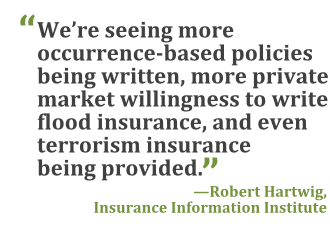 Prices are holding steady forcorporate buyers of casualty insurance products, and in cases wherethe loss experience has been particularly good, the premiums havefallen. On the property insurance side of the industry, it's abuyer's market, with prices falling at a quick clip. And in bothindustry houses, insurers eager to maintain market share are opento altering policy coverage terms and conditions.
Prices are holding steady forcorporate buyers of casualty insurance products, and in cases wherethe loss experience has been particularly good, the premiums havefallen. On the property insurance side of the industry, it's abuyer's market, with prices falling at a quick clip. And in bothindustry houses, insurers eager to maintain market share are opento altering policy coverage terms and conditions.
These are just some of the enticing tidbits risk managers cananticipate as they head into the annual April policy renewalseason. While not all companies renew their policies in thespringtime, most do. Unlike past market encounters, this go-roundpromises good deals along with the sunshine and flowers.
|Many carriers, for instance, are open to writing casualtyprimary and excess lines of coverage in occurrence-based policiesinstead of less favorable claims-made formats. Additionally,multiyear transactions are available in property, new sources ofprivate flood insurance capacity have opened up, and eventerrorism-related coverage in many policies are there for thetaking at little to no cost.
|The future bodes even better, with 92 percent of insurancecompany CEOs in a survey by PwC expressing confidence that theirrevenues will increase over the next three years, provided not byincreasing premiums but through technological advances,particularly the impact of data analytics on underwriting.
|Good Deals Galore
|All in all, it's not only a good time to be a risk manager, it'sabout time, too. Four years ago in Treasury & Riskmagazine, an article on risk managers began: “They're frightened,they're angry, and they're sleepless.” The title of the article wasinstructive: “Dreaming of Better Days Ahead.”
|Those days appear to have arrived. “The property/casualty marketis softening, apparently faster than we had predicted in October[2013]” said Matt Keeping, chief placement officer at insurancebroker Willis North America. “At that time, we were suggesting thatrates in the property, non-catastrophe market would be down 10 to12 percent and the catastrophe market down 5 to 10 percent. There'sbeen a bit of a change, with reductions now in the 15 to 20 percentrange for non-catastrophe and in the 5 to 20 percent range forcatastrophe. Things are accelerating.”
|The news is less bullish on the casualty side, but nonethelessupbeat. “We estimate that average rates are tight around the zeromark, with a slight plus or minus,” said Steve Kempsey, U.S.casualty leader at insurance broker Marsh. “Rates essentiallystabilized in 2013, although the guaranteed workers' compensationline is still difficult. Nevertheless, insurers are more willingthan in the past couple years to be flexible. … They're more apt tonegotiate on renewals.”
|He notes that a company “in a desirable risk class with adifferentiating risk profile can still see a good premiumreduction.”
|Robert Hartwig, president and chief economist at the NewYork-based Insurance Information Institute, agrees that the marketis softening in property, but less so for casualty business. “I'dsay prices are holding the line, depending on how aggressive theinsurer is to acquire and/or retain business,” Hartwig said.“Nevertheless, this is an improvement over where we were a yearago.”
What accounts for this improving picture? The primary factor isa flood of capacity coming into the reinsurance markets, givingprimary insurers more leeway to lay off assumed risks. For example,Everest Re's special purpose reinsurer, Mt. Logan Re, Ltd., securedadditional funding in January, bringing its current committedcapital to $370 million, well in excess of the initial target of$250 million. The special purpose reinsurance facility was formedlast year to provide collateralized capacity to the global propertycatastrophe reinsurance market.
|Such non-traditional reinsurance capacity, in addition to a lackof major U.S. catastrophe losses in 2013, have combined to lowerreinsurance rates for primary insurers, which is now trickling downto soften commercial pricing. “Everyone benefits when you've got arecord level of reinsurance capacity, which is the case right now,”said Keeping. “And the spigot remains open.” Additional sources ofnon-traditional capacity are flowing in from private equity, hedgefunds, and pension funds, he explains.
|This non-traditional capacity also is evident in the developmentof catastrophe bonds to further absorb property risk. “All thisalternative capacity is a new dynamic in the reinsurance market,”says Hartwig. “Combined with low catastrophe losses, it putsdownward pressure on pricing, expanding what reinsurers are willingto do—where they put their capital to work.”
||Other factors influencing the softer market include theimproving economy and rising investment income yields, although theobservers discount both. “The economy is certainly helping, but noone would have a parade over how well it is doing,” Keeping says.“And investment income just isn't playing as much of a role as inprevious insurance cycles. The focus instead is on growing profitsthrough improved underwriting data and actuarial analyses.”
|Kempsey shares this view. “More clients are using data analyticsand not just on the property side,” he said. “Our global analyticsteam has developed a cutting-edge tool for risk financingoptimization that helps companies structure insurance programs inthe most economically efficient manner, while meeting theorganization's risk tolerance goals.” He adds that the tool cantell companies if their financial limits of protection areappropriate, too high or too low.
|Preferred Policies
|Aside from generally favorable pricing conditions, theproperty/casualty market has also liberalized coverage terms andconditions for some classes and lines of business. “In 2013, theproperty market was experiencing a bit of a hangover fromSuperstorm Sandy, and some insurers were tightening up theirmanuscript policy forms, creating issues over incurred losses,”Keeping said.
|He's referring to the inability of some risk mangers toreinstate the financial limits on their property insurance policiesonce the limits were exhausted or eroded by Sandy-incurred losses.Although the policies remained in force until expiration, somecarriers were unwilling to extend additional limits of protection.And at policy renewal, several insurers offered new limits thatwere well below previous levels of insurance. “This is muchless of a concern today, but buyers nonetheless need to workclosely with their brokers to ensure optimum treatment,” Keepingsaid.
|Hartwig agrees, citing several examples where coverage terms andconditions are broadening. “We're seeing more occurrence-basedpolicies being written, more private market willingness to writeflood insurance, and even terrorism insurance being provided atminimal cost in many policies,” he said. “There's even talk fromsome carriers about putting up capacity for standalone terrorismcoverages.”
|Among these product enhancements is a new excess liabilitypolicy form put together by Marsh to minimize the oft-conflictingterms and conditions found in carriers' excess policies. “Whencompanies buy layers of insurance, they assume they all followform—they don't always,” Keeping said. “Sometimes the terms andconditions are different on a layer-by-layer basis, which cancreate holes in the program. The new form addresses theseinconsistencies.”
|Dave Hennes, risk manager at The Toro Company, aBloomington-based maker of turf, landscape, and irrigationequipment with $2 billion in 2013 revenues, exemplifies much ofwhat awaits risk managers in the April renewal season. In his lastrenewal, he was able to move the rest of the company's excesscasualty insurance from claims-made to occurrence coverage, sawimproved pricing on most lines of insurance, and was able to ink atwo-year property insurance policy to boot.
|“We had good results from a loss standpoint, which helped us,but what we're hearing is that the markets are softening due tocarriers' favorable reinsurance renewals,” the veteran risk managersaid.
|With regard to his next renewal, Hennes is upbeat: “I'mreasonably confident the good news will hold.”
Complete your profile to continue reading and get FREE access to Treasury & Risk, part of your ALM digital membership.
Your access to unlimited Treasury & Risk content isn’t changing.
Once you are an ALM digital member, you’ll receive:
- Critical Treasury & Risk information including in-depth analysis of treasury and finance best practices, case studies with corporate innovators, informative newsletters, educational webcasts and videos, and resources from industry leaders.
- Exclusive discounts on ALM and Treasury & Risk events.
- Access to other award-winning ALM websites including PropertyCasualty360.com and Law.com.
*May exclude premium content
Already have an account? Sign In
© 2024 ALM Global, LLC, All Rights Reserved. Request academic re-use from www.copyright.com. All other uses, submit a request to [email protected]. For more information visit Asset & Logo Licensing.







